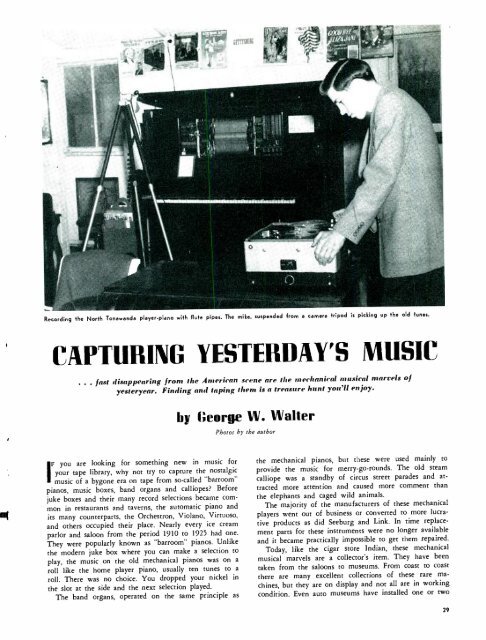Tape Recording Magazine - AmericanRadioHistory.Com
Tape Recording Magazine - AmericanRadioHistory.Com
Tape Recording Magazine - AmericanRadioHistory.Com
You also want an ePaper? Increase the reach of your titles
YUMPU automatically turns print PDFs into web optimized ePapers that Google loves.
<strong>Recording</strong> the North Tonawanda player -piano with flute pipes. The mike, suspended horn a camera tripod is picking up the old tunes.<br />
CAPTURING YESTERDAY'S MUSIC<br />
... fast disappearing from the American scene are the mechanical musical marvels of<br />
yesteryear. Finding and taping them is a treasure hunt you'll enjoy.<br />
by George W. Walter<br />
Photos by the author<br />
IF you are looking for something new in music for<br />
your tape library, why not try to capture the nostalgic<br />
music of a bygone era on tape from so- called "barroom"<br />
pianos, music boxes, band organs and calliopes? Before<br />
juke boxes and their many record selections became common<br />
in restaurants and taverns, the automatic piano and<br />
its many counterparts, the Orchestron, Violano, Virtuoso,<br />
and others occupied their place. Nearly every ice cream<br />
parlor and saloon from the period 1910 to 1925 had one.<br />
They were popularly known as "barroom" pianos. Unlike<br />
the modern juke box where you can make a selection to<br />
play, the music on the old mechanical pianos was on a<br />
roll like the home player piano, usually ten tunes to a<br />
roll. There was no choice. You dropped your nickel in<br />
the slot at the side and the next selection played.<br />
The band organs, operated on the same principle as<br />
the mechanical pianos, but these were used mainly to<br />
provide the music for merry -go- rounds. The old steam<br />
calliope was a standby of circus street parades and attracted<br />
more attention and caused more comment than<br />
the elephants and caged wild animals.<br />
The majority of the manufacturers of these mechanical<br />
players went out of business or converted to more lucrative<br />
products as did Seeburg and Link. In time replacement<br />
parts for these instruments were no longer available<br />
and it became practically impossible to get them repaired.<br />
Today, like the cigar store Indian, these mechanical<br />
musical marvels are a collector's item. They have been<br />
taken from the saloons to museums. From coast to coast<br />
there are many excellent collections of these rare machines,<br />
but they are on display and not all are in working<br />
condition. Even auto museums have installed one or two<br />
29
















